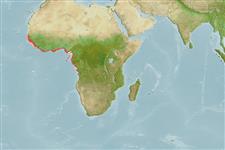>
Perciformes/Serranoidei (Groupers) >
Epinephelidae (Groupers)
Etymology: Cephalopholis: Greek, kephale = head + Greek, pholis = scale (Ref. 45335).
Eponymy: This is a toponym referring to the River Niger; the river (or its mouth, in the case of marine species) being the type locality. (Ref. 128868), visit book page.
More on author: Günther.
Environment: milieu / climate zone / depth range / distribution range
Ecologia
marinhas; estuarina demersal; intervalo de profundidade ? - 100 m (Ref. 26999), usually ? - 50 m (Ref. 57293). Tropical; 30°N - 14°S, 18°W - 13°E (Ref. 5222)
Eastern Atlantic: Senegal to Lobito, Angola, including the Canary Islands (Tenerife).
Tamanho / Peso / Idade
Maturity: Lm ? range ? - ? cm
Max length : 30.5 cm TL macho/indeterminado; (Ref. 57293); common length : 20.0 cm TL macho/indeterminado; (Ref. 26999)
Espinhos dorsais (total) : 9; Raios dorsais (total) : 14 - 15; Espinhos anais: 3; Raios anais : 8. Diagnosis: depth of body 2.8-3.0 in SL; head length 2.5-2.6 in SL; eye diameter greater than interorbital width, eye diameter 4.6-5.5 in HL; flat interorbital area; rounded preopercle, finely serrate, lower edge fleshy; subopercle and interopercle smooth; convex upper edge of operculum; maxilla scaly, reaching well past eye; lateral-body scales ctenoid, without auxiliary scales (Ref. 89707).
Occurs on mud (Ref. 5222), sand, and rock bottoms (Ref. 5222, 57293) in coastal waters, usually above 50 m depth (Ref. 57293). Exceptionally enters brackish lagoons and estuaries (Ref. 57293).
Ciclo de vida ou comportamento de acasalamento
Maturidade | Reprodução | Desova | Ovos | Fecundidade | Larvas
Heemstra, P.C. and J.E. Randall, 1993. FAO Species Catalogue. Vol. 16. Groupers of the world (family Serranidae, subfamily Epinephelinae). An annotated and illustrated catalogue of the grouper, rockcod, hind, coral grouper and lyretail species known to date. Rome: FAO. FAO Fish. Synop. 125(16):382 p. (Ref. 5222)
Status na Lista Vermelha da UICN (Ref. 130435: Version 2024-1)
Ameaça para os humanos
Harmless
Uso pelos humanos
Pescarias: sem interesse
Ferramentas
Relatórios especiais
Baixar XML
Fontes da internet
Estimates based on models
Preferred temperature (Ref.
123201): 19.2 - 27.9, mean 25.8 °C (based on 80 cells).
Índice de diversidade filogenética (Ref.
82804): PD
50 = 0.5000 [Uniqueness, from 0.5 = low to 2.0 = high].
Bayesian length-weight: a=0.01259 (0.00587 - 0.02699), b=3.04 (2.87 - 3.21), in cm total length, based on LWR estimates for this Genus-body shape (Ref.
93245).
Nível Trófico (Ref.
69278): 4.0 ±0.7 se; based on size and trophs of closest relatives
Resiliência (Ref.
120179): médio(a), tempo mínimo de duplicação da população 1,4 - 4,4 anos (Preliminary K or Fecundity.).
Fishing Vulnerability (Ref.
59153): Low vulnerability (21 of 100).
